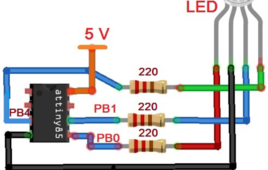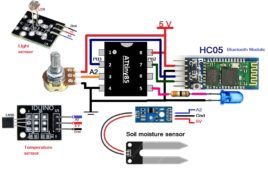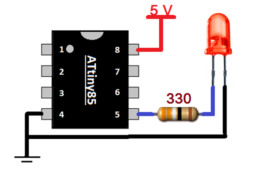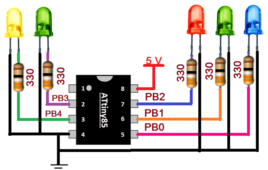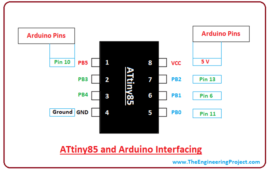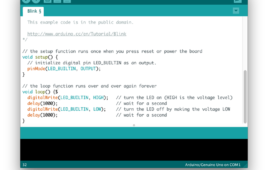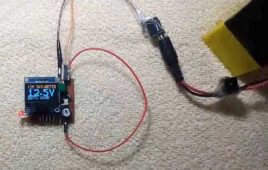In the previous tutorials in this series, we have seen how to generate different chasing effects by blinking LEDs. So we were simply turning the LED ON and OFF. In this tutorial, we shall vary the brightness (intensity) of LED. We shall use the PWM output of ATtiny85 to do this. So let’s see how…
ATtiny85 microcontroller tutorials, Part 6: LED intensity control using potentiometer and ATtiny85
In previous tutorials of this series, we saw how to vary the intensity (brightness) of LEDs using the PWM output of ATtiny85. This tutorial shall take it to the next step by varying LED brightness using a potentiometer (pot). The pot will give an analog output of 0 to 5V. ATtiny85 has an inbuilt ADC…
Tutorial 7: DC motor speed control using ATtiny85
In the previous two tutorials of this series, we have seen how to vary the intensity (brightness) of LEDs using the PWM output of ATtiny85. In this tutorial, we shall use a PWM output to vary the speed of a DC motor. DC Motor speed varies as the potentiometer is varied. As we have learned…
Tutorial 8: RGB LED interfacing with ATtiny85
In the previous three tutorials of this series, we saw how to vary the intensity (brightness) of LED and DC motor speed using the PWM output of ATtiny85. In all those previous tutorials, we used only one PWM output, but now we shall simultaneously use three PWM outputs of ATtiny85. ATtiny85 has three PWM outputs…
Tutorial 9: Device control using smart phone’s Bluetooth and ATtiny85
In this tutorial series, we have learned about interfacing potentiometer to get analog input, interfacing of RGB LED by generating PWM output, DC Motor speed control using PWM output, and some other things. This tutorial explains the serial communication of ATtiny85 with Bluetooth module HC05. ATtiny85 does not have built-in UART or USART with Rx…
Tutorial 10: Wireless sensor data transmitter using Bluetooth and ATtiny85
In the previous tutorial, we have learned how ATtiny85 serially communicates with Bluetooth module HC05 and send/receive commands from smartphone Bluetooth This tutorial also involves the role Bluetooth module HC05. But instead of receiving commands from a smartphone, it sends sensor data values to the smartphone. The sensor is connected to an analog input pin…
ATtiny85 microcontroller tutorials, Part 3: Building LED blinking application using ATtiny85
In the previous tutorial, we learned we need the following hardware and software tools to build any application using ATtiny85. Arduino IDE software USB SPI AVR programmer PROGISP software So let us build the first LED blinking, “hello world” application for the ATtiny85 microcontroller. Open Arduino IDE. Open LED blinking example from file->example->basic->blink Modify the…
ATtiny85 microcontroller tutorials, Part 4: LED chaser using ATtiny85
In the previous tutorial of this series, we have seen how to work with ATtiny85, how to program it, and also we have built our first – hello world application – that is LED blinking application using ATtiny85. So let us extend it to the next step – means one step advance. We shall connect…
ATtiny85 microcontroller tutorials, Part 1: Introduction
ATtiny85 microcontroller is a very popular 8-bit RISC microcontroller. It has become the first choice for professionals and developers because of its incredible features in such a small size. As its name suggests, it’s a tiny 8-pin (PDIP) microcontroller with almost all required features that any microcontroller should have such as built-in FLASH, EEPROM, SRAM,…
ATtiny85 microcontroller tutorials, Part 2: Working with ATtiny85
Working with ATtiny85 requires you to learn how to write a program for ATtiny85 and how to download it into its internal Flash memory. Would it surprise you to know that we can write programs for ATtiney85 in Arduino IDE? Yes, it is true. We can write, compile, create HEX files and even download the…
Miniature voltmeter with battery voltage monitor
Most of the times, measurement in electronic circuits, our requirement is measuring DC voltage. Normally, we will set the multi-meter to DC voltage mode and check the voltage levels at various points on the PCB. Mostly, our requirement lies between 5V to 15V DC. The circuit shown is simple, occupies less space and can directly connect to the DC voltage for measurement. To minimize the size and power consumption, 8 pin MCU and 0.96” OLED is used in the circuit.




